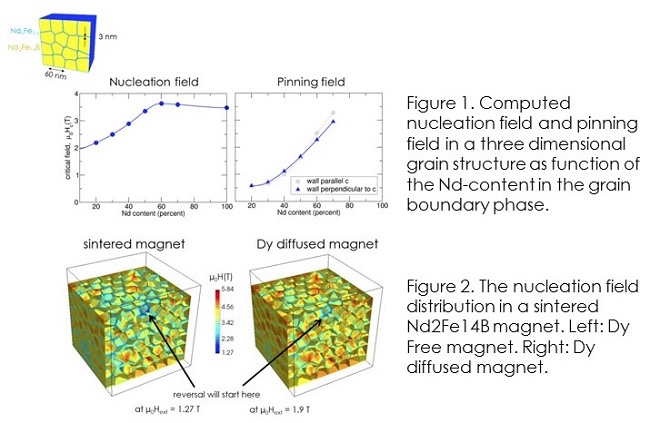Center for Integrated Sensor Systems, Danube University Krems, Austria
Abstract:
Owing to the advance of structural and chemical analysis of permanent magnets detailed microstructural information is available today. At the same time computer hardware as well as numerical methods improved considerably so that realistic micromagnetic simulations of magnetization reversal became possible.
There is clear evidence that the grain boundary phase in Nd2Fe14B magnets contains a significant amount of iron. The iron content depends on the orientation of the grain boundary with respect to the magnetocrystalline anisotropy axes of the grain. From a micromagnetic point of view the grain boundaries can be regarded as a thin soft magnetic defect. Such a soft magnetic layer embedded between hard grains may act as a nucleation site for the formation of reversed domains and as a pinning site for the domain wall motion. We computed the nucleation field and the pinning field in a granular microstructure as a function of the Nd content in a 3 nm thick grain boundary. The results presented in figure 1 show that the nucleation field is always higher than the pinning field. Unless there are surface defects that start magnetization reversal at lower fields the nucleation field will determine the coercivity of the sample.
Taking into account the magnetostatic interactions, we computed the distribution of the nucleation field in a large grained sintered magnet. Figure 2 compares the nucleation fields found in Dy free and Dy diffused sintered magnets. Reversal will start from the lowest nucleation field, which is found at triple junctions.
There is clear evidence that the grain boundary phase in Nd2Fe14B magnets contains a significant amount of iron. The iron content depends on the orientation of the grain boundary with respect to the magnetocrystalline anisotropy axes of the grain. From a micromagnetic point of view the grain boundaries can be regarded as a thin soft magnetic defect. Such a soft magnetic layer embedded between hard grains may act as a nucleation site for the formation of reversed domains and as a pinning site for the domain wall motion. We computed the nucleation field and the pinning field in a granular microstructure as a function of the Nd content in a 3 nm thick grain boundary. The results presented in figure 1 show that the nucleation field is always higher than the pinning field. Unless there are surface defects that start magnetization reversal at lower fields the nucleation field will determine the coercivity of the sample.
Taking into account the magnetostatic interactions, we computed the distribution of the nucleation field in a large grained sintered magnet. Figure 2 compares the nucleation fields found in Dy free and Dy diffused sintered magnets. Reversal will start from the lowest nucleation field, which is found at triple junctions.

This work was supported by the Austrian Science Fund (FWF): F4112 SFB ViCoM, the pioneering program “Development of magnetic material technology for high-efficiency motors” (2012–) commissioned by the New Energy and Industrial Technology Development Organization (NEDO), JST-CREST, and the EU EU Horizon 2020 NMBP23-2015 research No 686056 (NOVAMAG).



